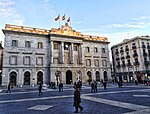Edifici de Sindicats
Buildings and structures in BarcelonaCatalan building and structure stubsNeoclassical architecture in BarcelonaOffice buildings completed in 1925

Edifici de Sindicats is monumental building in Barcelona. Built in 1925, initially occupied by the Caixa Mútua Popular ("People's Mutual Savings Bank"), later by the Francoist "vertical labor union" and finally by the democratic union organizations.
Excerpt from the Wikipedia article Edifici de Sindicats (License: CC BY-SA 3.0, Authors, Images).Edifici de Sindicats
Via Laietana, Barcelona
Geographical coordinates (GPS) Address Nearby Places Show on map
Geographical coordinates (GPS)
| Latitude | Longitude |
|---|---|
| N 41.3837 ° | E 2.1794 ° |
Address
Via Laietana 16
08003 Barcelona (Ciutat Vella)
Catalonia, Spain
Open on Google Maps











